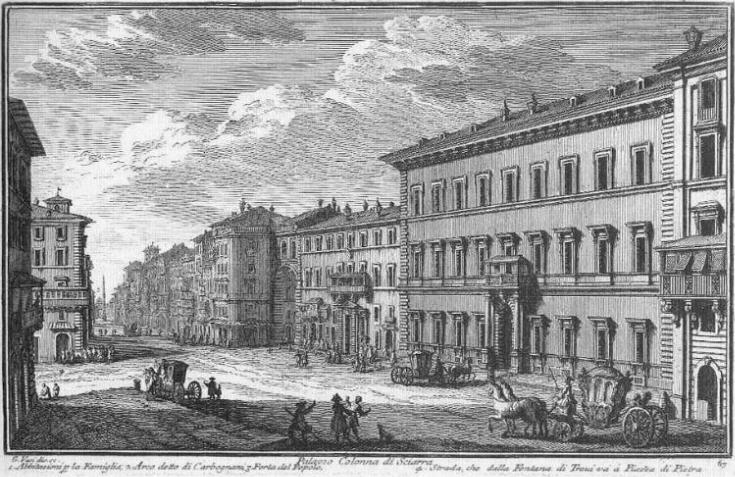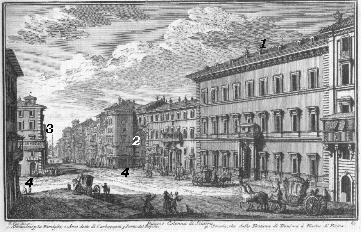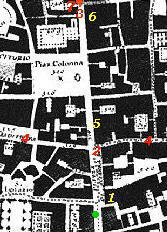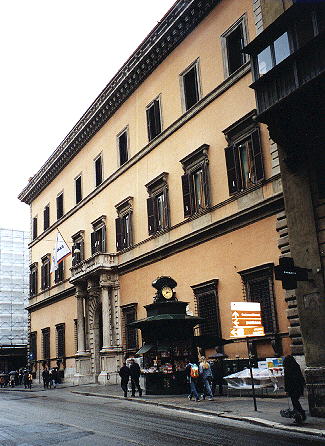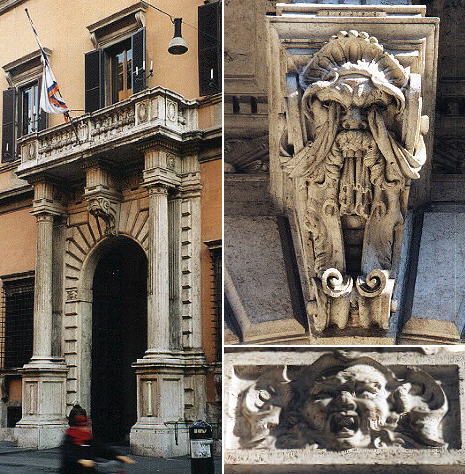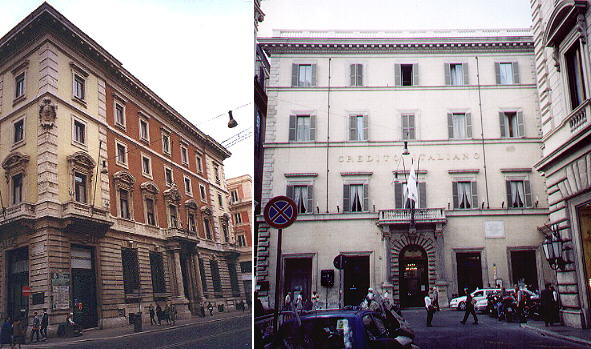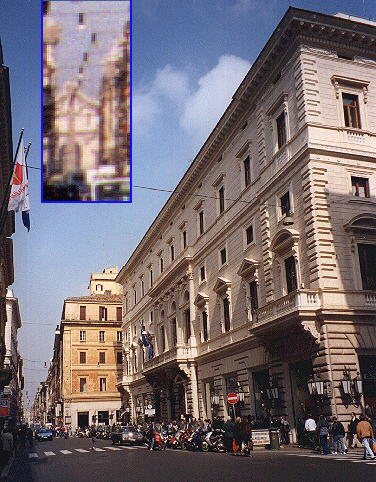

Palazzo Colonna di Sciarra
(Book
4) (Map
B3) (Day 1) (View C7) (Rione Colonna) and (Rione Trevi)
In this page:
The plate by Giuseppe Vasi
Today's view
The portal
Palazzo Buonacorsi and Palazzo Verospi
S. Maria Maddalena
delle Convertite
The Plate (No. 67)
In this view Vasi shows almost all Via del Corso and at the end of
it Piazza del Popolo. The subject is a very nice
palace built by Flaminio Ponzio in the XVIth century for the Colonna family
or more exactly for the Sciarra branch of it. The view is taken from the green dot in the small 1748 map here below.
In the description below the plate Vasi made reference to: 1) Palazzo Sciarra;
2) Arco di Carbognano (pulled down in the XIXth century when the central part of Via del Corso was enlarged);
3) Porta del Popolo;
4) Street linking Fontana di Trevi with Piazza di Pietra. 3), is shown in another page.
The small map shows also 5) Palazzo Bonaccorsi; 6) S. Maria Maddalena delle Convertite; 7) Palazzo Verospi.
The dotted line in the small map delineates
the borders between Rione Colonna (top left quarter), Rione Pigna (lower left quarter) and Rione Trevi (lower right quarter).
Today
The palace, today a bank, is well preserved, only there is not that
little covered balcony from which the landlords could look at the people
in the street. In the nearby palace the little covered balcony is still
there.
The Portal
The portal is a later addition and it is considered a masterpiece.
It seems simple but is actually very complex in combining several different
elements. It has something of the early Florentine Renaissance, but hides
full Baroque bizarre details.
Palazzo
Buonacorsi and Palazzo
Verospi
Most of the buildings shown in the plate immediately after Palazzo
Colonna were pulled down at the end of the XIXth century to enlarge Via
del Corso. Palazzo Buonacorsi was replaced by Palazzo della Banca Commerciale
Italiana. The portal is very similar to that of Palazzo Colonna.
Palazzo Verospi, built at the beginning of the XVIIth century
by Girolamo Rainaldi and Onorio Longhi, was modified in the XIXth century with shops replacing the ground floor windows.
It is currently owned by a bank. Next to it Palazzo Theodoli, a XVIth century palace, was pulled down in 1886 and replaced by a new building.
S.
Maria Maddalena
delle Convertite
Rome was not exactly a very moral city in the past. Via di Ripetta
was paid for by a tax levied on the prostitutes (or more correctly, especially
with reference to the XVIth century, the courtesans) living in the
area. There were several attempts to bring them back to the right way so
many institutions were dedicated to Mary Magdalen. A large building has
replaced in Via del Corso the church and nunnery of S. Maria Maddalena.
The street leading from Via del Corso to Piazza
S. Silvestro is still called Via delle Convertite (converts). The insert in the
photo shows the obelisk of Piazza del Popolo.
Excerpts from Giuseppe Vasi 1761 Itinerary related to this page:
Piazza e Palazzo di Sciarra
Dal palazzo del Principe di Carbognano della nobilissima famiglia Colonna di
Sciarra prende questa piazza il suo nome, ed è molto frequentata dalla nobiltà; e
cittadinanza per le botteghe del caffè, specialmente per quella del Veneziano, in cui
si trovano oltre l'esquisite bevande calde, e fredde, anco de' canditi, e confetture
particolari.
Il palazzo fu eretto col disegno di Flaminio Ponsio; il portone però è magnifica
architettura di Giacomo Barozzio da Vignola, ed è maraviglioso per li smisurati macigni,
da' quali fu cavato: ed è sommamente notabile, che nel Pontificato di Pio IV. facendosi
i fondamenti di questo, furono trovati alcuni pezzi di bassirilievi col ritratto
dell'Imperatore Claudio; e dipoi l’anno 1641.facendosi un nuovo scavo nella piazza,
alla profondità di palmi 23. fu ritrovato l’antico pavimento della Via Flaminia,
che quì colla Lata si univa, e trovaronsi ancora alcune colonne rotte di marino
affricano, un pezzo di capitello, ed una gran porzione di lapide con iscrizione del
suddetto Claudio, ed altresì una medaglia d'oro del medesimo Imperatore, avendo da
una parte là di lui effigie, e nome, e dall'altra un arco con statua equestre,
le quali cose danno a vedere, che quei marmi furono dell'arco, che secoli fa stava per
l’appunto, dove ora la strada di fontana di Trevi traversa il Corso.
Palazzo Verospi
Questo per le preziose statue,
e busti antichi merita una visita particolare, e ancora per le pitture a fresco di
Francesco Albani, ed il maraviglioso strumento armonico, ove in un medesimo tempo
suonano diversi strumenti.
Chiesa e Monastero di S. Maria Maddalena
Da Onorio I. fu eretta quivi la chiesa sopra un'altra dedicata a s Lucia: ma essendo
poi nell'an. 1520. da Leone X. conceduta alla Confraternita della Canta, Paolo V.
vi aggiunse un conservatorio per le povere donne penitenti, e però rinnovandosi la chiesa,
fu dedicata a s. Maria Maddalena: ora però vi risiedono Religiose vergini sotto la regola di
sant' Agostino; e nella chiesa vi è un Crocifisso dipinto da Giacinto Brandi, e la s.
Maria Maddalena del Guercino da Cento.
|
Next plate in Book 4: Palazzo Ruspoli sul Corso
Next step in Day 1 itinerary: Dogana
di terra (Piazza di Pietra)
Next step in your tour of Rione Colonna: Dogana
di terra (Piazza di Pietra)
Next step in your tour of Rione Trevi: Chiesa di S. Marcello

Go
to  or to Book
4 or to my Home
Page on Baroque Rome or to my Home Page on Rome
in the footsteps of an XVIIIth century traveller.
or to Book
4 or to my Home
Page on Baroque Rome or to my Home Page on Rome
in the footsteps of an XVIIIth century traveller.
|


